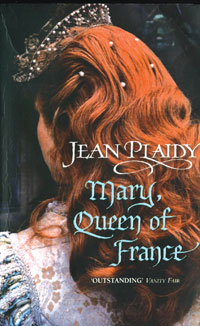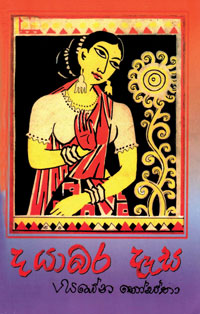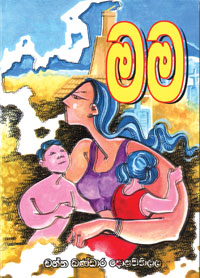Books
A powerful sketch of 16th century royalty
Mary, Queen of France
Author: Jean Plaidy
Arrow Books
Whoever thinks history is a bore should read Jean Plaidy's historical
novels. The European history is brought to life in such a manner that
only a few would be able to resist this gripping novel. Sure, we know
the tale of the lovely Princess Mary Rose but the story is presented
with such taste that one can hardly resist the urge to keep on turning
the pages.

Princess Mary Tudor, the youngest sister of King Henry VIII, is one
among the few whom he adored unconditionally. Known throughout Europe
for her charm and beauty the whole world seemed to be at Mary's feet.
Yet the bliss must eventually come to an end when she is faced with the
most important matter of her life - marriage.
Unwilling and rebellious the golden child of the Tudors was sent to
France as a peace offering to marry the ailing King Louis, so much her
senior. True to her Tudor blood, Mary would do anything to reach her
goal - to reunite with her true love, Charles Brandon. Her passion takes
her beyond boundaries to venture as far as to defy her brother, the most
feared man in Europe.
Most of us are familiar with the backdrop of the royal family during
the reign of Henry VIII. He is England's most charming king, well known
for his colourful life, from marrying six times to breaking away from
the Roman Catholic Church and making himself head of the English church.
Yet never had readers been so close to the characters, never had they
been given the chance to understand the sentiments and actions of the
ancestors of the English empire as Plaidy had presented them through her
novels. Each and every character is not only sketched but the reader is
put in the shoes of the protagonists, made to live his or her life and
follow their actions and thoughts.
They are meant to share their joys and rejoices and sympathise with
them in their tears and sorrows. Though their final destiny had joined
history the reader is never spared a dull moment, rather there is a
magical quality in the simple words and phrases, such stubble
understanding between the main characters and the author that the
readers are kept waiting, expectant, for history to unveil before them,
themselves as much a part of its mystery.
"Mary, Queen of France" reflects the turn of events from the eyes of
the 11-year-old Mary Rose till her end. Readers are given a glimpse of
the personality of people close to her like her brother, Henry VIII, her
first husband, King Louis of France, her sister-in-law, Katharine of
Aragon, her lover, Charles Brandon, the Dauphin of France who later
succeeded Louis, Francoise I etc. Plaidy reveals history through her own
eyes skillfully woven together by true accounts.
Every minute detail proves to be exciting through the lines flowing
out of her pen. History is laced together with drama and romance
bringing forth a work of art in story telling fashion.
No doubt many bookworms will find the tale fascinating. The readers
are allowed to test the characters according to their own judgment as
there are many more books relating the tales of each of the other
characters in the same manner so admirable in Plaidy.
For instance "The Lady in the Tower" tells the story from Anne
Boleyn's side while books like "Katharine, the Virgin Widow" and "The
Shadow of the Pomegranate" brings to light the life of Katharine of
Aragon, the first wife of Henry VIII. Similarly the life, lies and
plights of the Tudors and those of whom are closely linked to them are
related in several volumes such as "Uneasy Lies the Head", "The King's
Secret Matter", "Murder Most Royal", "St. Thomas's Eve", "The Sixth
Wife", "The Thistle and the Rose", "Lord Robert", "Royal Road to
Fotheringay" and "The Captive Queen of Scots". This is almost good as
knowing them in person!
"Mary, Queen of France" joins a line of outstanding novels of Plaidy
aka Victoria Holt for her mystery novels and Philippa Carr for her
"Daughters of England" series.
These are the pen names she adapted in writing fiction from different
genres. Her real name is Eleanor Hibbert.
Ruwini Jayawardana
Memoirs of an octogenarian
Dayabara Desa (The Loving Eyes), a short story collection Piyasena
Costa
S Godage and Brothers
150 pages. Rs. 250.
Piyasena Costa's latest work is more likely a collection of memoirs
of an octogenarian with a vast knowledge and authority on old classics.
His latest short story collection of 16 reads elegant with its touches
on classics mainly stemming from Buddhist culture.

It may sound odd to mention that the best source of modern creative
literature is studying old classics. But it is so, and the old classics
should be researched properly. Only the creative writer distinguishes
the proper methodology. He does not just take out an outdated term, but
he moulds it suitable into the modern society.
Costa is an erudite scholar of Sanskrit and Pali, from which Sinhala
is derived. Costa's language, because of this reason, is simple but
refined. The scene flow shows his fluency on the language.
Take his title story that is full of metaphors. He goes a few decades
back to his school days and gets trapped in nostalgia for a moment. Text
books are fuel that energises the students. The teacher-pupil bond was
strong.
The metaphor of the text books being fuel shows how pupils were
adhered to their school duties when outsiders such as Television and
computer were quite unheard of. The pupils discover a photograph of a
pupil in the possessions of a young teacher.
This was enough to spread the word, but later on it was discovered
that the photograph belongs to the young teacher's brother who looks
exactly like the pupil. The young teacher develops a bond with the whole
class taking them all as her brothers.
During the 50's Costa's lyrics brought him much fame. 'Isurumuniyehi
Petali Galaka A...', 'Dambulu Gale', Dakunu Lake Aga Nagare'; the list
goes further up with the count of over 200 songs.
His professional teaching career started in 1947 with being later
promoted into a painting lecturer position at Lanka Technical College in
1952.
Costa's versatility started when he wrote the script to 'Ashoka' a
film by Sirisena Wimalaweera. His acting debut was P. Welikala's 'Davasaka
Venasa'. His other publications are Geetha Rasaya, Kala Shilpa, Piyuma,
Sansara Chakraya, and Isurumuniya.
Born in 1925 in Galle, Cost first showed painting talents at the age
of 17, with the painting of Rabindranath Tagore. His first achievement
was winning the first place at a competition held in 1944.
Sachitra Mahendra
Analysis of the history of Sri Lankan people
D.C.R.A. Goonetilleke "Sri Lankan English Literature and the Sri
Lankan People 1917-2003" (Colombo: Vijitha Yapa Publications, 2nd edn.
with a new Appendix: 'Leonard Woolf's Divided Mind: the case of The
Village in the Jungle', 2007). Pages 318, Hard cover Rs 750, Paperback
Rs 590, Available at www.vijithayapa.com
This series of in-depth studies of varied aspects of Sri Lankan
Literature in English results in a richly detailed presentation of the
field from its beginnings to the present day. The canvas is crowded with
a host of writers whose work reflect the contributory forces, historical
and social, which shape their output.
The history of Sri Lankan English Literature is viewed in the context
of the history of the Sri Lankan people and such major events as
Independence, the Social Revolution of 1956, the Insurgencies of 1971
and 1988-89, and the ethnic conflict as recorded in the literature are
comprehensively examined. Literature is considered here in its widest
sense as it appears in newspapers and journals as well as in books.
While the central focus is on literature after Independence, the
literature from 1917 onwards is analysed to provide a complete
understanding of the subject. The second edition includes an original
interpretation of "The Village in the Jungle" as an appendix. Professor
Goonetilleke's inquiry is informative and penetrating.
It is meant for general readers who wish to be acquainted with the
English literary scene in Sri Lanka as well as those who take a
specialized interest in the field. D.C.R.A Goonetilleke is the
internationally recognised authority on Sri Lankan English Literature.
He was Foundation Visiting Fellow at Clare Hall, University of
Cambridge, Henry Charles Chapman Visiting Fellow at the Institute of
Commonwealth Studies, University of London, and Guest Professor of
English at the University of Tubingen, Germany.
He was the International Chairperson of the Association for
Commonwealth Literature and Language Studies (ACLALS) and Vice-President
of the Federation Internationale de Languages et Literature Modernes (FILLM).
His books include Developing Countries in British Fiction, Images of
the Raj, Joseph Conrad: Beyond Culture and Background, Salman Rushdie
and Joseph Conrad's Heart of Darkness (available at Vijitha Yapa
Bookshops).
Dr. Gamini Fonseka
Collection of seven short stories
It's hard to explain the benefits of becoming a journalist. Being a
journalist simply means having an unlimited visa to travel the man's
life. But you have to grab a chance to get your experience published in
a book form one day. Only a few have achieved this challenge. Martin
Wickramasinghe, Dayasena Gunasinghe, Prof. Ediriweera Sarachchandra and
a few others top the list.

Channa Bandara Dolapihilla has journalistic experience of over 30
years, and no doubt he has travelled a lot in man's life. With his short
story collection of 7 he shares but briefly some of his experiences with
us. Those experiences are sombre at times, indifferent most of the time.
What is admired about Dolapihilla is that his use of language is simple
and readable; this is more accredited to the discipline he has gained
from being a journalist. And his story plots are somewhat strange.
Take his first, the title story for instance. The narrator is dead!
What the reader visualises is what the dead narrates. He observes the
funeral environment without him getting involved in it, but yet in which
he has become the centre of attraction.
He observes the hypocrisy of the living beings: majority being his
relations, and others, the well-wishers. The second story, though based
on a common plot, is presented in a novel way; a servant boy thinking
about his past, and the story ends with his dream world shattered by the
beating of the lady of the house.
The third story, a translation from a Bulgarian source, brings us the
warmth and the greatness of motherhood. The story, however, would have
been better had the author taken simple steps to make it look more
original; the translation seems so word-to-word.
The fourth story is the most readable, as it involves a lot of
dialogues within. Although it's based on the common issue of political
lackeys, the story is a little different as author narrates how a
state-run company high-up spends the election-day with tension.
The most interesting story is woven around a drug addict. Dolapihilla
has not mentioned a single word about the drug addiction though it is
the main subject of the story.
Dolapihilla's work is interesting that can be finished within a very
short period. Just try out reading it, it's just 55 pages!
Sachitra |

